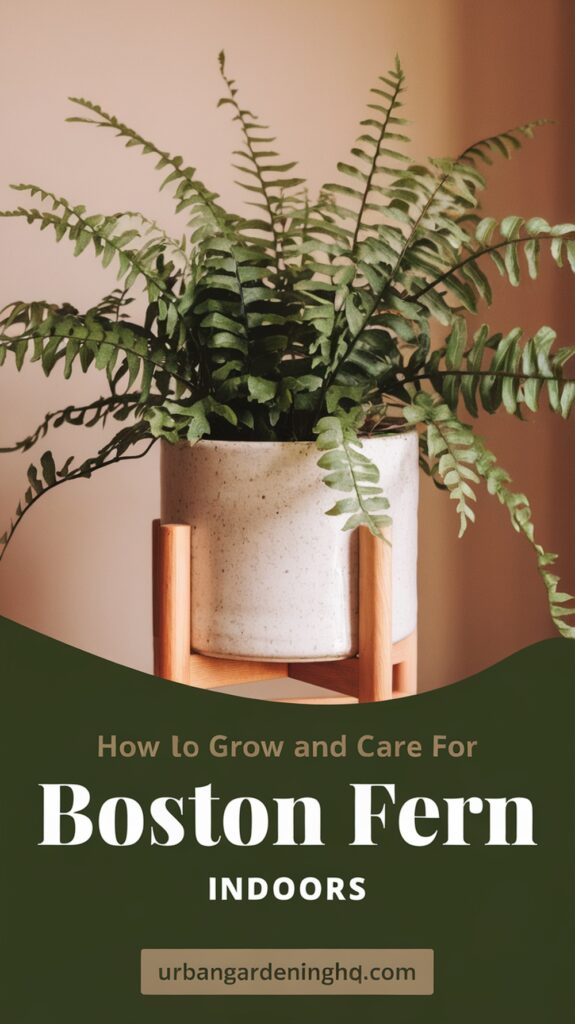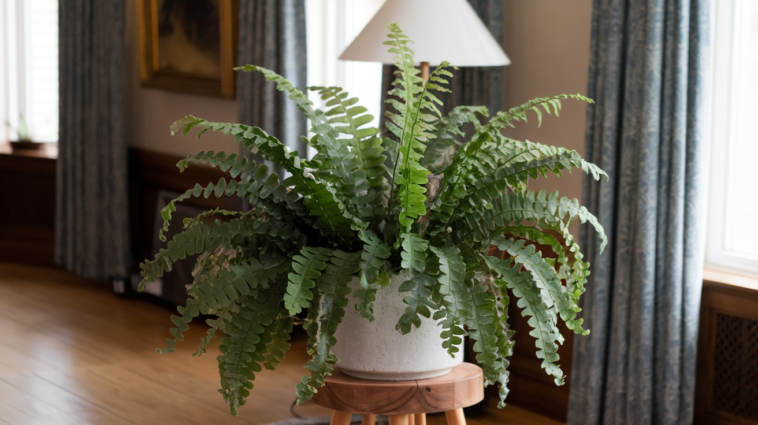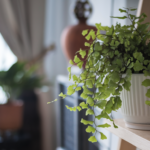I’m excited to share my expertise on caring for Boston Fern houseplants. They can make your indoor space lush and beautiful. With the right care, Boston Ferns can be stunning additions to any home.
In this article, I’ll share valuable insights on keeping your Boston Fern healthy. We’ll cover topics from understanding your plant to creating the perfect environment. By the end, you’ll be a Boston Fern expert, enjoying the beauty of these plants in your home.
Understanding Your Boston Fern

To help your Boston fern thrive, knowing its natural home and growth habits is key. Boston ferns come from tropical areas, where they grow on the forest floor. They love filtered sunlight and constant moisture. This info is vital for caring for your fern.
There are many types of Boston ferns, each with its own traits. Knowing these differences helps you care for your plant better. Boston ferns are great for indoor spaces because they’re easy to care for and adapt well.
Natural Habitat and Growth Patterns
Boston ferns love humid places with steady temperatures. To mimic their natural home, ensure your fern gets the right moisture and temperature. This will help it grow well and avoid common problems.
Different Boston Fern Varieties
Popular Boston fern types include the Boston fern, maidenhair fern, and rabbit’s foot fern. Each has its own leaf shape and growth style. Knowing these differences helps you care for your fern better.
Why Boston Ferns Make Excellent Houseplants
Boston ferns are great for indoor spaces because they clean the air and add beauty. With the right care, your fern can flourish and enhance your home. Simple care tips and understanding your fern’s needs will make it a wonderful addition.
Creating the Perfect Growing Environment
Exploring indoor plants, I’ve learned that the right growing environment is key. For houseplants like Boston ferns, the right temperature, humidity, and light are vital. Simple gardening tips can help you create the perfect space for your Boston fern to grow well.
Boston ferns love temperatures between 65-75°F (18-24°C) and high humidity, over 50%. They need bright, indirect light but avoid direct sunlight. By keeping these in mind, you can make a great home for your indoor plants.
Here are some important things to think about for your Boston fern’s environment:
- Temperature: Keep your Boston fern in an area with a consistent temperature between 65-75°F (18-24°C)
- Humidity: Maintain a humid environment, typically above 50%, to promote healthy growth
- Light: Provide bright, indirect light, avoiding direct sunlight that can cause damage
By following these tips, you can enjoy your Boston fern’s beauty and benefits. With the right conditions, your indoor plants will flourish. You’ll get to see their unique traits and enjoy their advantages.
Light Requirements and Placement

When I care for my Boston Fern, I’ve found that the right light is key. Boston Ferns love bright, indirect light. They’re great for rooms with east- or west-facing windows. It’s important to find the right balance of light. Too much direct sunlight can burn the leaves, while too little can make them weak and stretched out.
To find the best spot for your Boston Fern, think about the light needs of other plants. For instance, if you’re growing begonias, check out urban gardening resources for their light needs. Knowing the light needs of different plants helps you create a beautiful indoor garden.
Ideal Light Conditions
Boston Ferns do best in filtered or dappled light. You can get this by placing them near a sheer curtain or shade. This kind of light lets the fern photosynthesize and grow without getting burned.
Best Locations in Your Home
The best spots for your Boston Fern are near a window or in a bright, indirectly lit room. Don’t put your fern in direct sunlight, like south-facing windows. Also, avoid dark places like basements or rooms without windows.
Seasonal Light Adjustments
As the seasons change, you might need to adjust your fern’s light. In spring and summer, move it to a brighter spot. In fall and winter, find a place with more filtered light.
Proper Watering Techniques
As a houseplant lover, I’ve learned watering is key for Boston Fern care. I keep the soil moist but not too wet. I check the soil every day and water when the top inch feels dry.
This method stops over-watering, which can cause root rot. It also prevents under-watering, which makes leaves dry and brittle.
Boston Ferns need careful watering and the right spot to grow well. The care guidelines say they need 0.5 cups of water every 7 days, more if they’re not in direct sunlight. I place my fern near a south-facing window, less than 6 feet away. I also repot it when it doubles in size or every year, using soil that drains well and has enough nutrients.
Here are some tips for watering your Boston Fern:
- Water in the morning so the plant can absorb it all day
- Don’t get water on the leaves to avoid fungal diseases
- Use room-temperature water to avoid shocking the roots
By using these watering tips, your Boston Fern will thrive and add beauty to your home.
Humidity: The Key to Lush Boston Fern Growth
When I care for my Boston Fern, I’ve learned that humidity is key. Boston Ferns love humid places, needing 50-60% relative humidity. I use a hygrometer to check and keep the humidity right in my home.
To help my Boston Fern, I create a humid spot for it. I put the fern on a tray with water and pebbles or use a humidifier. These steps help keep the air around my fern just right.
Here are some ways to keep your Boston Fern happy and healthy:
- Placing the plant on a tray with pebbles and water
- Using a humidifier, specially in dry seasons
- Grouping indoor plants together to create a microclimate
By keeping the humidity right, my Boston Fern grows lush and green. It adds beauty and freshness to my home.
Soil and Fertilization Requirements

To keep my Boston Fern happy, I need the right soil and fertilization. A potting mix made for ferns is key, as regular soil can hold too much water. I also fertilize it in spring and summer with a balanced fertilizer. But, I must dilute it to half strength to protect the roots.
For more details on caring for my Boston Fern, I check out the Boston Fern care guide. By following these tips, I can ensure my fern grows well.
Here are some important points for soil and fertilization for my Boston Fern:
- Using a well-draining potting mix made for ferns
- Fertilizing in spring and summer with a balanced fertilizer
- Diluting the fertilizer to half strength to avoid root damage
Pruning and Maintenance Tips
To keep your Boston Fern healthy, regular pruning and maintenance are key. As a Boston Fern owner, I’ve learned that the right techniques make it lush and beautiful. Pruning is vital for its shape and bushy growth.
For pruning, use clean, sharp scissors or pruning shears. This avoids damaging the plant. Here are some tips to remember:
- Trim your Boston Fern regularly to maintain its shape and promote bushy growth.
- Remove any dead or dying fronds to prevent the spread of disease and encourage new growth.
- Use a gentle touch when handling the plant to avoid causing unnecessary stress.
By following these simple tips, your Boston Fern will look its best. Enjoy its beautiful foliage for years. Also, remember to provide the right light, water, and humidity for a thriving environment.
| Maintenance Task | Frequency | Tips |
|---|---|---|
| Pruning | Regularly | Use clean, sharp scissors or pruning shears |
| Watering | Daily | Check soil moisture and water as needed |
| Humidity | Daily | Monitor and adjust humidity levels as needed |
Common Boston Fern Problems
As a houseplant lover, I’ve found that even the healthiest Boston Fern can face common issues. It’s important to regularly check your plant for any problems. Look out for pests like spider mites, mealybugs, or scale, which can harm your fern if not treated.
Diseases are another issue Boston Ferns can get. Yellow leaves or black spots are signs of disease. It’s vital to act fast to stop it from getting worse. Also, keeping up with fertilization helps prevent nutritional problems that can weaken the plant.
Some common problems with Boston Ferns include:
- Pests: spider mites, mealybugs, scale
- Diseases: yellowing leaves, black spots
- Nutritional deficiencies: weak growth, discolored leaves
Knowing about these issues and how to prevent them can help your Boston Fern stay healthy. With the right care, your fern can add beauty and greenery to your home.
| Common Problem | Solution |
|---|---|
| Pests | Isolate the plant, treat with insecticidal soap |
| Diseases | Remove infected leaves, improve air circulation |
| Nutritional deficiencies | Adjust fertilization schedule, provide balanced nutrients |
Propagation Methods and Tips
As a Boston Fern enthusiast, I’m excited to share my knowledge on propagation methods and tips. Propagation is a great way to share plants with friends and family, or to create new plants for your own collection. With the right gardening tips, you can successfully propagate your Boston Fern and enjoy its beautiful, lush foliage.
When it comes to propagation, there are a few methods to choose from. Here are some of the most effective methods:
- Division: This involves separating the rhizome into sections and replanting them. It’s a simple and effective method that works well for Boston Ferns.
- Spore propagation: This method involves collecting and sowing the spores. It’s a more complex method, but can be rewarding for experienced gardeners.
The best time for propagation is during the spring and summer months when the plant is actively growing. This allows the new plants to establish themselves before the winter months. By following these gardening tips and using the right propagation method, you can successfully multiply your Boston Fern and enjoy its beauty for years to come.
Seasonal Care Guide
As a Boston Fern owner, you need to change your care routine with the seasons. In spring and summer, your fern needs more water and food to grow well.
In fall and winter, water and feed it less because it’s dormant. This helps avoid too much water and root rot. Here are some seasonal care tips:
- Humidity levels: Boston Ferns like a humid spot, between 50-70% humidity. Use a humidifier or a water tray with pebbles to boost humidity.
- Temperature control: Keep your fern in a spot with a steady temperature of 65-75°F (18-24°C). This helps it grow well.
- Pest control: Check your fern often for pests like spider mites, mealybugs, and scale. Treat it quickly if you find any pests.
By following these seasonal care tips, you’ll help your Boston Fern thrive. It will become a stunning addition to your home.
Special Care for Indoor Boston Ferns
As a houseplant lover, I’ve found that indoor Boston ferns need special care. To keep them happy, keep the temperature between 65-75°F (18-24°C). This range helps them grow strong and healthy, making them a lovely addition to your home.
It’s important to keep your Boston fern away from heating or cooling vents. These vents can cause big temperature swings, harming your plant. Instead, place it in a spot with good air flow to prevent fungal diseases. Here are some tips to keep in mind:
- Keep your Boston fern away from direct sunlight, which can cause the leaves to become scorched.
- Use a humidifier to maintain a humid environment, which is important during dry winter months.
- Water your fern regularly, but make sure not to overwater, which can lead to root rot.
By following these tips and giving your indoor Boston fern the right care, you can enjoy its lush, green foliage and beautiful texture. With proper care and attention, your Boston fern can thrive as a stunning houseplant, adding natural beauty to your home.
| Temperature Range | Humidity Level | Lighting Requirements |
|---|---|---|
| 65-75°F (18-24°C) | 50-60% | Indirect sunlight |
Conclusion
As we wrap up our exploration of Boston fern houseplants, I hope you now see their beauty. Learning how to care for them will make your home more vibrant. It also sparks a love for these special plants.
Caring for your Boston Fern is a journey that’s both rewarding and challenging. It needs patience and a keen eye for detail. With the right care, your plant will grow into a stunning, lush greenery.
Keep enjoying the growth of your Boston Fern. Share your journey with others. The Boston Fern community is full of people who love to help and celebrate.
The true joy of Boston Ferns is the bond we form with nature at home. Let your Boston Fern remind you of nature’s beauty and strength. Enjoy the happiness of caring for these amazing plants.


